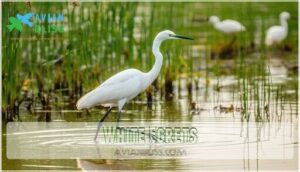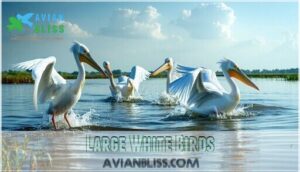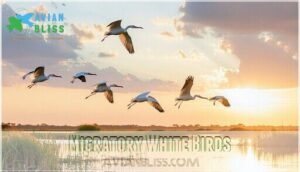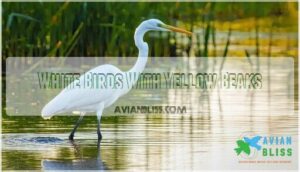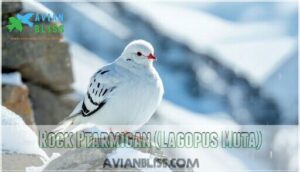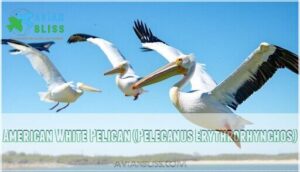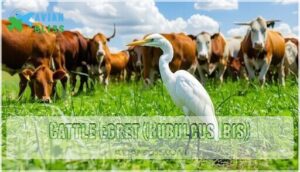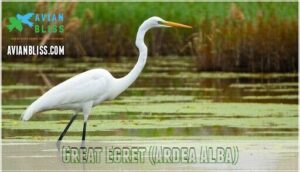This site is supported by our readers. We may earn a commission, at no cost to you, if you purchase through links.

Common species include the elegant Snowy Egret with its bright yellow feet, the massive American White Pelican boasting a nine-foot wingspan, and the adaptable Cattle Egret that follows livestock for easy meals.
These birds inhabit everything from coastal wetlands to mountain peaks, with some like the Rock Ptarmigan changing from brown to white seasonally.
Whether you’re spotting wading birds in shallow waters or watching pelicans soar overhead, identifying these species becomes easier once you know their telltale features and preferred hangouts.
Table Of Contents
- Key Takeaways
- White Egrets
- Large White Birds
- Migratory White Birds
- White Birds With Yellow Beaks
- White Birds Found in Aquatic Habitats
- Rock Ptarmigan (Lagopus Muta)
- American White Pelican (Pelecanus Erythrorhynchos)
- Cattle Egret (Bubulcus Ibis)
- Great Egret (Ardea Alba)
- White Ibis (Eudocimus Albus)
- Frequently Asked Questions (FAQs)
- Are there white birds in the wild?
- What are the different types of white birds?
- How many types of white birds are there in North America?
- Are all white birds rare?
- What are some white bird names?
- What does a white bird mean?
- What kind of bird is white?
- What is a large graceful white bird?
- What is an example of a white bird?
- How rare is it to see a white bird?
- Conclusion
Key Takeaways
- You’ll identify white birds more easily by learning their distinctive features like the Snowy Egret’s bright yellow feet, the American White Pelican‘s massive nine-foot wingspan, and the White Ibis’s curved bill for probing muddy bottoms.
- You can find different white bird species in specific habitats – egrets and ibises wade through wetlands and marshes, pelicans soar over open waters, while ptarmigans inhabit mountain peaks and change from brown to white seasonally.
- You’ll spot these birds using unique feeding behaviors that make identification straightforward – Cattle Egrets follow livestock for insects, pelicans work together to herd fish, and Great Egrets stand motionless before striking with lightning speed.
- You’re witnessing conservation success stories when you see these birds, as many species like the Snowy Egret and Great Egret recovered from near extinction through protective laws and habitat restoration efforts.
White Egrets
You’ll find white egrets among the most graceful wading birds in wetlands, marshes, and shallow waters across North America.
These elegant hunters include species like the Snowy Egret and Cattle Egret, each with distinct feeding behaviors and physical characteristics that make them easy to identify in the field, showcasing their unique characteristics.
Snowy Egret
With its striking yellow feet and jet-black bill, the Snowy Egret stands out among white birds.
This elegant wader nearly vanished during the late 1800s when plumage hunting devastated populations. Today, it’s a conservation success story thanks to protective laws and habitat recovery efforts.
Key identification features include:
- Bright yellow feet contrasting with black legs
- Slender, sharp black bill for precise fishing
- Pure white plumage with graceful S-shaped neck
Their feeding behavior involves patient stalking in shallow wetlands, making white bird species identification straightforward.
Cattle Egret
You’ll spot the Cattle Egret following livestock through pastures, creating a perfect cattle symbiosis.
This compact white bird species excels at insect foraging, snatching grasshoppers and beetles stirred up by grazing animals.
Their global distribution spans six continents, with nesting colonies often shared with other herons.
| Characteristic | Details |
|---|---|
| Size | 17-23 inches, 9.5-18.2 oz |
| Habitat | Grasslands, farms, wetlands |
| Conservation Status | Stable, expanding range |
Large White Birds
When you’re looking for impressive white birds, you’ll find that large species like the American White Pelican and White Ibis command attention with their size and distinctive features.
These birds, with their broad wingspans and prominent bills, are easy to spot in wetlands and coastal areas where they hunt for fish and other aquatic prey.
American White Pelican
You’ll recognize American White Pelicans by their massive nine-foot wingspans and signature orange pouches.
These large white birds excel at group fishing, working together to herd fish into shallow water.
Their nesting habits involve ground colonies on isolated islands.
Unlike their brown cousins, they don’t dive-bomb for food.
Conservation status remains stable thanks to wetland protection efforts supporting this impressive bird species.
American White Ibis
You’ll find the American White Ibis wading through southeastern wetlands with its distinctive curved bill, hunting crustaceans and small fish.
These white birds prefer shallow marshes and coastal areas for their Ibis Habitat needs. Their Ibis Behavior includes probing muddy bottoms methodically. Understanding their Ibis Diet helps with white birds identification during your birdwatching adventures.
They’re known to forage in urban parks and lawns, adapting to human-altered environments.
What makes these birds truly special:
Pure white wings against emerald wetlands—nature’s most stunning contrast that stops every birdwatcher in their tracks.
- Their graceful curved bills perfectly adapted for probing soft sediments
- Striking contrast of pure white plumage against dark wetland backgrounds
- Essential role in maintaining healthy wetland ecosystems through pest control
- Vulnerable nesting colonies that need our protection from habitat destruction
- Ancient lineage connecting us to millions of years of avian evolution
Ibis Conservation efforts focus on protecting their breeding colonies, while their Nesting Habits involve building stick platforms in trees near water.
These remarkable white birds face threats from habitat loss, making bird identification skills vital for monitoring their populations in various bird habitats.
Migratory White Birds
The remarkable journeys of migratory white birds showcase nature’s most impressive navigation systems.
These feathered travelers follow ancient migration patterns, covering thousands of miles between their breeding grounds and winter habitats. You’ll witness incredible endurance as they navigate using stars, magnetic fields, and geographical landmarks.
Key Migration Facts:
- Snow Goose: Travels from Arctic coastal colonies to southern U.S. marshes, covering up to 3,000 miles
- Trumpeter Swan: Migrates from northern breeding sites to ice-free waters along the Pacific Coast
- Tundra Swan: Makes epic journeys from Arctic tundra to North American coastal wintering areas
- Arctic Tern: Completes the longest migration on Earth, flying from Arctic to Antarctic waters
- Snowy Owl: Moves south during harsh winters, sometimes reaching the northern United States
Climate impacts increasingly affect these bird migration patterns, making conservation efforts essential for protecting their traditional routes and ensuring these white birds continue their seasonal movements successfully.
The American White Ibis, for example, inhabits southeastern U.S. wetlands, foraging for aquatic prey.
White Birds With Yellow Beaks
Yellow beaks serve as nature’s golden calling cards among white birds, making identification easier for dedicated birdwatchers.
The striking bill coloration creates stunning contrasts against pristine white plumage, particularly evident in species like the Great Egret and Cattle Egret. These avian beauties showcase their bright yellow bills during feeding habits, using them as precision tools to snag fish, insects, and small prey from various environments.
During mating displays, males often exhibit more vibrant beak colors to attract potential partners. The Great Egret’s dagger-like yellow bill becomes especially prominent during breeding season, while juvenile plumage typically features duller beak tones that intensify with age.
White birds with yellow beaks demonstrate remarkable habitat variation, from wetland marshes to grassland pastures. The Great Egret, or Ardea alba, is a breeder of low conservation concern.
Whether you’re observing the elegant Great Egret stalking through shallow waters or watching Cattle Egrets following livestock, these distinctive beak features make field identification straightforward for both novice and experienced bird enthusiasts.
White Birds Found in Aquatic Habitats
Aquatic environments host some of nature’s most stunning white birds.
You’ll discover species perfectly adapted to life around water, from shallow marshes to open lakes. These birds showcase fascinating behaviors that’ll captivate any observer.
Key aquatic white bird features:
- Snowy Egret – Yellow feet contrast against black legs while wading through shallow waters
- American White Pelican – Massive wingspan spans nearly eight feet during cooperative feeding displays
- Great Egret – Standing three feet tall, it strikes with lightning-fast precision at fish
- Cattle Egret – Breeds in wetlands despite preferring open grasslands for foraging
- White Ibis – Curved bill perfectly designed for probing muddy marsh bottoms
Consider exploring Snowy Egret merchandise for bird enthusiasts.
Rock Ptarmigan (Lagopus Muta)
Rock Ptarmigan (Lagopus muta) showcases remarkable seasonal camouflage among white birds. You’ll spot these masters switching from pure white winter plumage to mottled brown summer feathers, perfectly matching snow-covered terrain and rocky surfaces.
Their alpine adaptations include feathered feet that work like natural snowshoes. Diet variations shift from winter buds to summer insects and berries.
Watch for their unique mating rituals where males display red eyebrows. Hybridization risks exist with Willow Ptarmigan.
These bird adaptations represent nature’s finest bird camouflage engineering.
American White Pelican (Pelecanus Erythrorhynchos)
American White Pelican (Pelecanus Erythrorhynchos) stands among the most impressive large white birds you’ll encounter in North America.
These magnificent birds showcase remarkable Physical Traits, including wingspans reaching nearly eight feet and distinctive orange bills that develop seasonal breeding ornaments.
Their Group Fishing techniques set them apart from other white birds—they work together like a coordinated team, herding fish into shallow waters before collectively scooping up their catch.
Understanding their Diet Specifics reveals they primarily consume fish, though they’ll occasionally eat amphibians and crustaceans.
Their Nesting Habits involve ground colonies on isolated islands, where pairs create simple scrapes lined with debris.
Conservation Status remains stable, though habitat protection stays important for maintaining healthy populations throughout their white birds habitat range.
Key identification features:
- Massive orange bill with expandable pouch
- Pure white plumage with black flight feathers
- Soaring flight pattern in V-formations
Cattle Egret (Bubulcus Ibis)
While the American White Pelican commands attention with its massive wingspan, the Cattle Egret (Bubulcus ibis) proves that size isn’t everything.
These compact white birds measure 17-23 inches with distinctive yellow beaks and black legs. You’ll spot them following livestock across pastures, demonstrating remarkable Symbiotic Relationships with grazing animals.
Their Foraging Behavior is fascinating—they snatch insects disturbed by cattle hooves, making them valuable pest controllers. Originally from Africa, their Global Expansion now spans six continents, showing incredible adaptability to diverse white birds habitat.
| Characteristic | Details |
|---|---|
| Nesting Habits | Colonial nesters in trees near water |
| Diet | Insects, frogs, small reptiles |
| Breeding | 3-4 eggs, 25-day incubation |
Their Conservation Status remains stable, though wetland protection helps maintain populations. These white birds in backyard settings often follow farm equipment, making them surprisingly approachable for birdwatchers seeking white birds diet observations.
Great Egret (Ardea Alba)
This elegant wading bird stands as one of nature’s most graceful white birds, reaching up to 39 inches tall with distinctive long legs perfectly adapted for wetland life.
You’ll spot the Great Egret in freshwater marshes, ponds, and coastal areas where it employs patient hunting strategies—standing motionless before striking with lightning speed.
Physical Description: Pure white plumage with a yellow-orange bill and black legs distinguishes this species from other white birds with long legs.
Habitat Preference: Prefers shallow wetlands, including freshwater marshes, tidal flats, and pond edges.
Diet Analysis: Primarily feeds on fish, frogs, and small aquatic creatures caught through precise spear-like strikes.
Conservation Status: Once nearly extinct due to plume hunting, populations have successfully recovered through protective legislation.
- Watch for their S-shaped neck coiled like a spring, ready to release devastating precision
- Marvel at their ability to remain statue-still for minutes, embodying nature’s ultimate patience
- Feel your heart skip as they transform from motionless sentinel to lightning-fast predator
- Experience the thrill of spotting their magnificent breeding plumes dancing in spring breezes
White Ibis (Eudocimus Albus)
With its distinctive curved bill and snow-white plumage, the White Ibis stands out among white birds with long legs.
You’ll recognize this graceful wader by its football-shaped body and bright pink facial skin during breeding season.
Physical traits include a wingspan reaching 38 inches and weight up to 2.3 pounds.
White Ibis habitat range spans coastal wetlands from Virginia to South America, with Florida hosting the largest populations.
These white birds in garden settings often visit suburban areas near water sources.
Their Ibis diet consists mainly of crayfish, crabs, and aquatic insects, which they probe for using their specialized bills.
Nesting habits involve colonial breeding in trees and shrubs, typically 2-15 feet above ground.
Conservation status remains stable, though habitat loss poses ongoing challenges.
Unlike the larger American White Pelican, White Ibises prefer shallow waters for foraging and maintain strong social bonds year-round.
They’re known to inhabit shallow wetland environments, favoring depths around 13.4 cm.
Frequently Asked Questions (FAQs)
Are there white birds in the wild?
Nature’s snowy canvas showcases stunning white birds throughout wild landscapes.
You’ll spot Snow Geese migrating in massive flocks, Snowy Owls hunting across arctic tundra, and elegant swans gliding through pristine wetlands during your outdoor adventures.
What are the different types of white birds?
You’ll find dozens of white bird species worldwide, including swans, egrets, doves, geese, owls, and ptarmigans.
Each has evolved unique adaptations for survival in different habitats from arctic tundra to tropical waters.
How many types of white birds are there in North America?
Countless white birds call North America home! You’ll spot around twenty-five distinct species, including snowy owls, trumpeter swans, cattle egrets, and various ptarmigans that change colors seasonally for survival.
Are all white birds rare?
White birds aren’t all rare.
You’ll spot common species like cattle egrets, mute swans, and snow geese regularly.
However, some like ivory gulls and whooping cranes remain endangered due to habitat loss and climate change.
What are some white bird names?
You’ll encounter Snow Geese, Mute Swans, and Snowy Owls in nature.
Cattle Egrets, Great Egrets, and White Ibises wade through wetlands.
Rock Ptarmigans, Tundra Swans, and Trumpeter Swans complete this diverse group of stunning white-feathered species.
What does a white bird mean?
Symbolically, you’ll find white birds represent purity, peace, and spiritual messages across cultures.
They’re often seen as divine messengers or signs of hope, transformation, and new beginnings in your life’s journey.
What kind of bird is white?
Like snow-dusted angels across the sky, you’ll spot many white birds in nature.
Swans glide gracefully on water, while snowy owls hunt silently.
Doves symbolize peace, and egrets wade through marshes hunting fish.
What is a large graceful white bird?
You’re likely thinking of a swan, with its elegant curved neck and pristine feathers. These majestic birds can weigh up to 34 pounds and boast wingspans reaching 94 inches across waterways.
What is an example of a white bird?
The Great Egret stands as a perfect example of a white bird. You’ll spot this elegant wader in wetlands across North America, standing motionless before striking fish with lightning-fast precision.
How rare is it to see a white bird?
Seeing white birds isn’t particularly rare since many common species display white plumage.
You’ll frequently spot cattle egrets, great egrets, and mute swans in various habitats, making white bird sightings quite regular.
Conclusion
Spotting these magnificent types of white birds is like discovering living sculptures painted against nature’s canvas.
You’ll find success by learning each species’ unique features, preferred habitats, and seasonal patterns.
From wetland egrets to soaring pelicans, these birds offer endless opportunities for observation and photography.
Remember to bring binoculars, visit appropriate habitats during peak activity times, and practice patience.
With this knowledge, you’re equipped to identify and appreciate the diverse types of white birds enriching North America’s landscapes.

